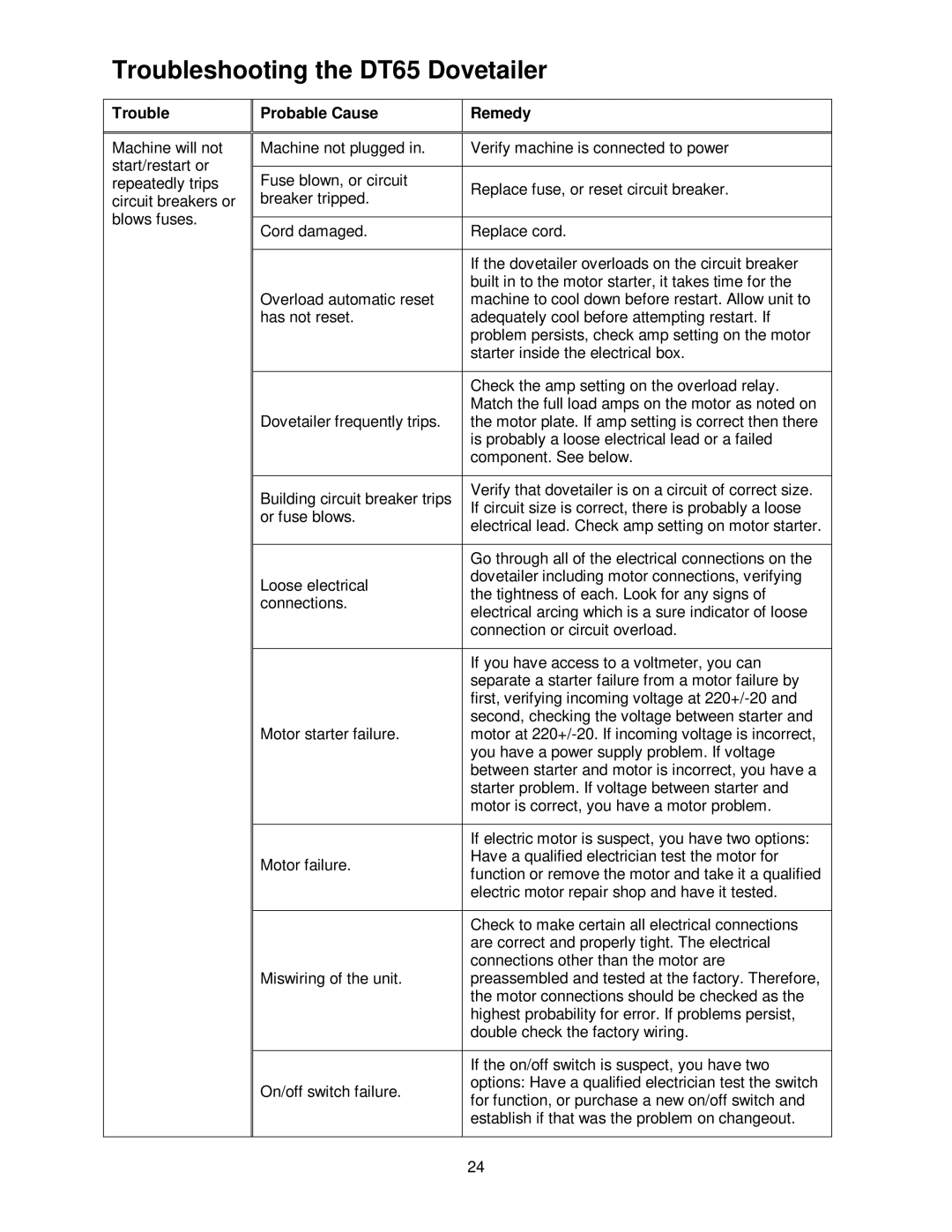
Troubleshooting the DT65 Dovetailer
Trouble
Machine will not start/restart or repeatedly trips circuit breakers or blows fuses.
Probable Cause | Remedy | |
|
| |
Machine not plugged in. | Verify machine is connected to power | |
|
| |
Fuse blown, or circuit | Replace fuse, or reset circuit breaker. | |
breaker tripped. | ||
| ||
|
| |
Cord damaged. | Replace cord. | |
|
| |
| If the dovetailer overloads on the circuit breaker | |
| built in to the motor starter, it takes time for the | |
Overload automatic reset | machine to cool down before restart. Allow unit to | |
has not reset. | adequately cool before attempting restart. If | |
| problem persists, check amp setting on the motor | |
| starter inside the electrical box. | |
|
| |
| Check the amp setting on the overload relay. | |
Dovetailer frequently trips. | Match the full load amps on the motor as noted on | |
the motor plate. If amp setting is correct then there | ||
| is probably a loose electrical lead or a failed | |
| component. See below. | |
|
| |
Building circuit breaker trips | Verify that dovetailer is on a circuit of correct size. | |
If circuit size is correct, there is probably a loose | ||
or fuse blows. | ||
electrical lead. Check amp setting on motor starter. | ||
| ||
|
| |
| Go through all of the electrical connections on the | |
Loose electrical | dovetailer including motor connections, verifying | |
the tightness of each. Look for any signs of | ||
connections. | ||
electrical arcing which is a sure indicator of loose | ||
| ||
| connection or circuit overload. | |
|
| |
| If you have access to a voltmeter, you can | |
| separate a starter failure from a motor failure by | |
| first, verifying incoming voltage at | |
Motor starter failure. | second, checking the voltage between starter and | |
motor at | ||
| you have a power supply problem. If voltage | |
| between starter and motor is incorrect, you have a | |
| starter problem. If voltage between starter and | |
| motor is correct, you have a motor problem. | |
|
| |
| If electric motor is suspect, you have two options: | |
Motor failure. | Have a qualified electrician test the motor for | |
function or remove the motor and take it a qualified | ||
| ||
| electric motor repair shop and have it tested. | |
|
| |
| Check to make certain all electrical connections | |
| are correct and properly tight. The electrical | |
| connections other than the motor are | |
Miswiring of the unit. | preassembled and tested at the factory. Therefore, | |
| the motor connections should be checked as the | |
| highest probability for error. If problems persist, | |
| double check the factory wiring. | |
|
| |
| If the on/off switch is suspect, you have two | |
On/off switch failure. | options: Have a qualified electrician test the switch | |
for function, or purchase a new on/off switch and | ||
| ||
| establish if that was the problem on changeout. | |
|
|
24
